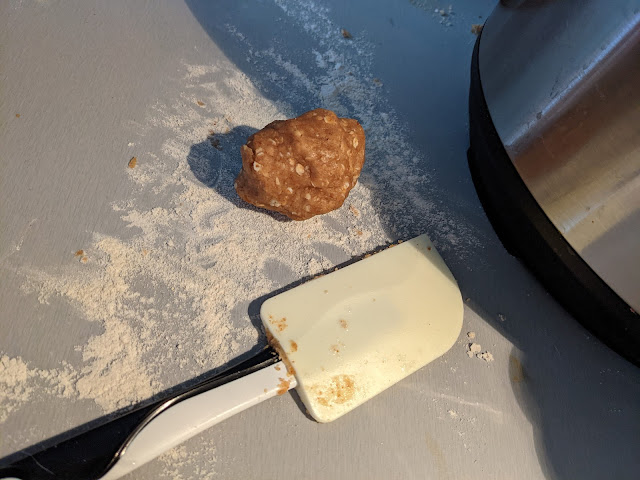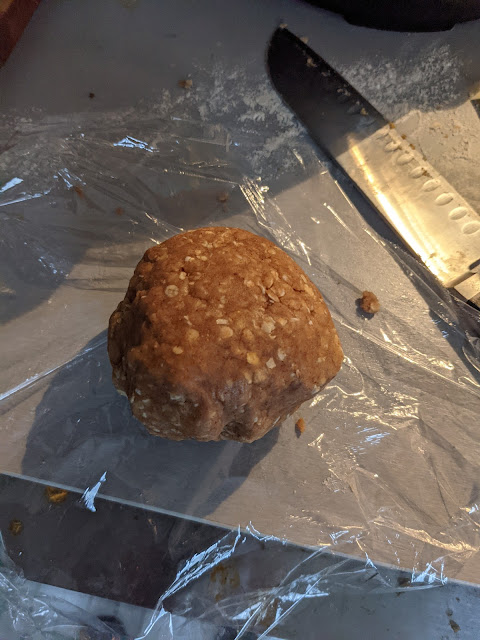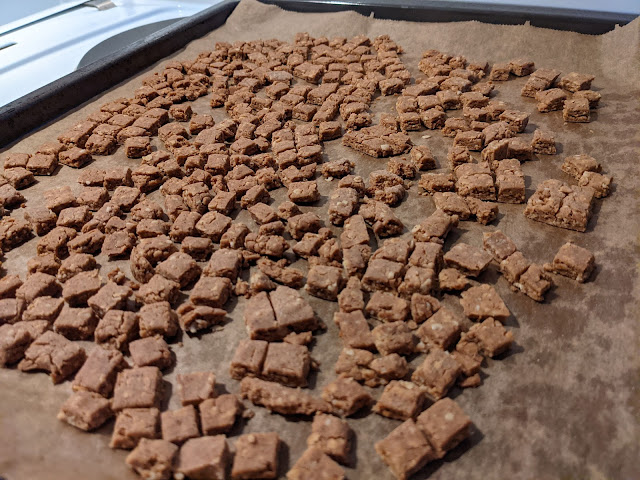Gluten Free Peanut Butter Dog Treats
I managed to make these today:
Based on King Arthur Baking's Best Of Breed Dog Biscuits
Gluten Free Peanut Butter Dog Biscuits
80g buckwheat flour
80g brown rice flour
80g potato starch
100g rolled oats - I used quick cooking
3 eggs (2 of mine were mediums, 1 large. I'd probably stick with three eggs though because gluten free dough, extra proteins to keep it all together)
270g peanut butter
1/2 tsp salt
1/2 cup almond milk
Preheat oven to 300F/150°C.
Line a baking sheet with parchment paper.
Mix together the dry ingredients.
Add the eggs and peanut butter, mix till incorporated - it will be crumbly and not a cohesive dough yet.
Add the almond milk, and extra if needed to create a cohesive dough.
Divide into two halves, roll out one half (or less, depending on your space) to 1/2cm thickness or so.
Cut into shapes - what shapes is entirely up to you. Big round cookies, dog bones, fun animal shapes, tiny squares? They all work. How many cookies you get out of this will of course depend on what you do here.
Bake at 300F till the cookies seem dry - you may have to cut one open to check. Mine took about 45 minutes.
I used a hand mixer with dough hooks to stir in the wet ingredients, as this can be a bit much for a whisk. A wooden spoon might do the trick too, but I had a hand mixer, so I used that.
As I am looking for extra options for training treats, I'm going with fairly small squares, and the next round may be even smaller. Ideally they can be fed to a puppy and chewed while still moving, without needing to stop and make a production out of it.
Why gluten free? In this case, mostly because I don't have wheat flour in the house. I don't eat wheat/gluten containing flours because of low fodmap currently. (Low FODMAP does not care about gluten, but the flours that contain it happen to also be ones that contain fructans, which low FODMAP does care about)
I've made the King Arthur recipe more than once before, including with organic stone ground whole wheat pastry flour - I guess my dogs get only the fanciest flours.
Also, when Puppy was on a wheat containing food, he was itchier - although I can't say for sure it was the wheat or any of the other ingredients, we haven't done a careful elimination. It could really have been any number of factors.
Why weights?
Because gluten free flour substitutions are easier that way - you use the same weight of flour as the original, but substitute GF flours and starch in a ratio of 2:1. I did not think to pour them into a measuring cup in between.
Maybe I will next time.
In theory it should have been 76g each but who has that kind of precision, and my scale is sometimes a little wonky. I went with 80 and close enough. Also, it should have been 90g oats, I didn't check the recipe for that one and misremembered how many grams of oats make up one cup. In my mind, it's 100g is one cup. But again, close enough. It all worked out.
Why these choices?
He's tried to eat my buckwheat flour straight out of the box it came in before. So I thought he'd probably like this. Also, it's what I have. Potatoes are in his regular food, and I think brown rice is too. I thought it would be better to split the flour so they were not all buckwheat and introduce that more slowly. Feel free to just use one flour instead, cornstarch or tapioca starch instead if those are more your/your dogs thing.
Why no powdered milk?
Because I didn't have any. That's the only reason. I've used peanut butter powder to substitute for it in the past, too - any dog-acceptable protein powder would do really. Or, skip it, and be careful about your liquids, start with the half cup, go from there.
Given that Puppy gets other treats too, including dried duck, chicken, and steamed chicken, I'm not really worried about his protein intake being too low.
GF doughs tend to like a little extra liquid anyway, so even with an extra egg and without the milk powder, the half cup of almond milk was just right. The dough came out fairly pliable even if cracking around the edges. You don't want it super soft all the way, you're just putting it in the oven to dry it out again anyway.
Why almond milk?
I guess that was my compromise - I didn't have powdered milk, so instead of water I used almond milk for the liquid. Should add a smidge of calcium, maybe. I don't keep cow's milk around, I did have almond milk. That's basically the whole line of thinking here. Feel free to use water instead!
Unlike the wheat versions, these did not really brown much. But that is hardly surprising. I haven't gotten a lot of browning on GF baked goods yet, certainly not without sugar being involved.
My oven is also tiny, so this one batch is actually four trays worth of baking.
Back in Worcester, I would make double batches on two half sheets at a time, but that was a different time and an oven about twice the size.
I don't actually mind this approach. Each batch takes me about ten minutes to roll, flatten, cut, and transfer to the tray. That's about how long my food needs to warm up anyway, so it's a pleasant sort of thing to do on the side.
Also, I guess we'll see how browning develops over time?
My buckwheat waffles barely brown after an hours rest time - but the next day, I get pretty nice browning on the same batch, so it's possible that with an overnight rest, the browning will look different!
Also I guess this is one way to think about working in the future if I want browning - try resting GF doughs overnight. After all, what am I worried about? That my blondies will get too tough and bready? For that to happen, I would need gluten to exist in the dough. Although for all I know there are other secret drawbacks that I have not learned about yet. Guess I'll find out sometime.
My knowledge of GF baking is very much a work in progress and I hardly know much at all right now. My GF baking is still very much in the early stages.
Dog treats are about as adventurous as I've gotten. That and waffles. And both of those are fairly forgiving.
Puppy was initially skeptical, but now is pretty happy to accept these treats as treats and to work for them.
Don't worry, it was not all peanut butter treats. And I didn't let him do this for long. I was however impressed with his determination and creativity.
However, this is not how we earn treats in this household, so instead, I gave him the opportunity to earn them with a round of practice. He possibly enjoyed that more than helping himself, in the end.










Comments
Post a Comment